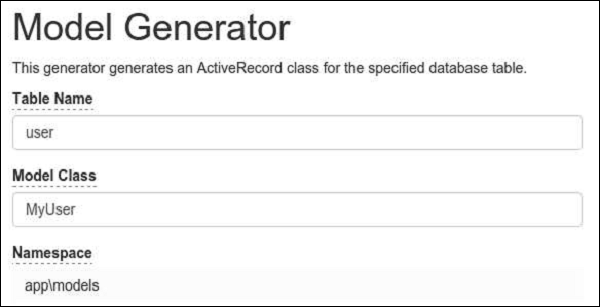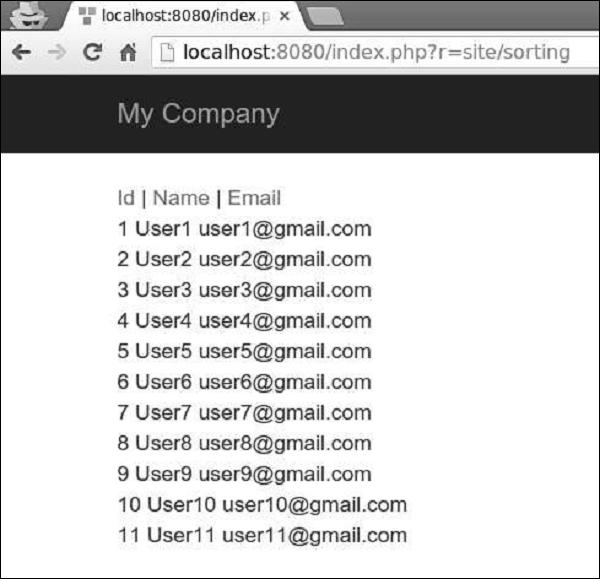📅 最后修改于: 2020-10-16 07:18:30 🧑 作者: Mango
当显示大量数据时,我们经常需要对数据进行排序。 Yii使用yii \ data \ Sort对象来表示排序模式。
为了显示排序,我们需要数据。
准备数据库
步骤1-创建一个新的数据库。可以通过以下两种方式来准备数据库。
-
在终端中运行mysql -u root –p
-
通过CREATE DATABASE helloworld创建一个新数据库。CHARACTER SET utf8 COLLATE utf8_general_ci;
步骤2-在config / db.php文件中配置数据库连接。以下配置适用于当前使用的系统。
'yii\db\Connection',
'dsn' => 'mysql:host=localhost;dbname=helloworld',
'username' => 'vladimir',
'password' => '12345',
'charset' => 'utf8',
];
?>
步骤3-在根文件夹中运行./yii migration / create test_table 。此命令将创建数据库迁移以管理我们的数据库。迁移文件应显示在项目根目录的迁移文件夹中。
步骤4-以这种方式修改迁移文件(在本例中为m160106_163154_test_table.php )。
createTable("user", [
"id" => Schema::TYPE_PK,
"name" => Schema::TYPE_STRING,
"email" => Schema::TYPE_STRING,
]);
$this->batchInsert("user", ["name", "email"], [
["User1", "user1@gmail.com"],
["User2", "user2@gmail.com"],
["User3", "user3@gmail.com"],
["User4", "user4@gmail.com"],
["User5", "user5@gmail.com"],
["User6", "user6@gmail.com"],
["User7", "user7@gmail.com"],
["User8", "user8@gmail.com"],
["User9", "user9@gmail.com"],
["User10", "user10@gmail.com"],
["User11", "user11@gmail.com"],
]);
}
public function safeDown() {
$this->dropTable('user');
}
}
?>
上面的迁移将创建一个用户表,其中包含以下字段:ID,名称和电子邮件。它还增加了一些演示用户。
步骤5-在项目根目录内运行./yii migration,以将迁移应用于数据库。
步骤6-现在,我们需要为我们的用户表创建一个模型。为了简单起见,我们将使用Gii代码生成工具。打开以下网址:http:// localhost:8080 / index.php?r = gii 。然后,单击“模型生成器”标题下的“开始”按钮。填写表名称(“用户”)和模型类(“ MyUser”),单击“预览”按钮,最后单击“生成”按钮。

MyUser模型应出现在models目录中。
进行排序
步骤1-将actionSorting方法添加到SiteController 。
public function actionSorting() {
//declaring the sort object
$sort = new Sort([
'attributes' => ['id', 'name', 'email'],
]);
//retrieving all users
$models = MyUser::find()
->orderBy($sort->orders)
->all();
return $this->render('sorting', [
'models' => $models,
'sort' => $sort,
]);
}
步骤2-在views / site文件夹内创建一个名为sorting的View文件。
link('id') . ' | ' . $sort->link('name') . ' | ' . $sort->link('email');
?>
= $model->id; ?>
= $model->name; ?>
= $model->email; ?>
步骤3-现在,如果您在Web浏览器中键入http:// localhost:8080 / index.php?r = site / sorting ,您可以看到ID,名称和电子邮件字段是可排序的,如下图所示。
